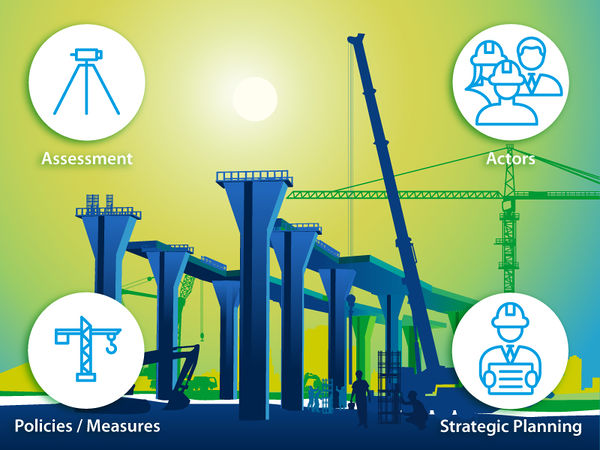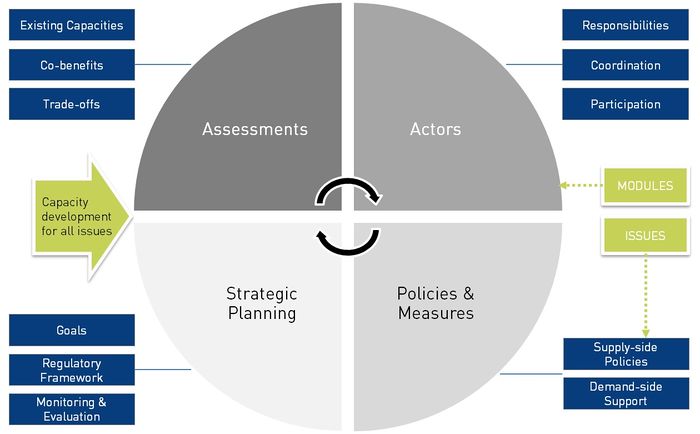Difference between revisions of "SE4Jobs Toolbox"
***** (***** | *****) |
***** (***** | *****) m |
||
| (13 intermediate revisions by 2 users not shown) | |||
| Line 1: | Line 1: | ||
| + | == <span style="color:#000080">'''SE4Jobs Toolbox''' <span style="color:#000080"><span class="st">– </span>Laying the foundations for a sustainable development</span></span><br/> == | ||
| − | + | {{SE4ALL Toolbox}} | |
| − | < | + | <br/>{{template:Tabs-5 |
| − | + | |SE4Jobs Toolbox|Overview | |
| − | + | |SE4Jobs Toolbox - Assessment|Assessment | |
| − | + | |SE4Jobs Toolbox - Actors|Actors | |
| − | + | |SE4Jobs Toolbox - Policies & Measures|Policies & Measures | |
| + | |SE4Jobs Toolbox - Strategic Planning|Strategic Planning | ||
| + | }} | ||
== Introduction == | == Introduction == | ||
| − | The | + | The SE4Jobs Toolbox was developed by an expert group in order to provide guidance on key issues and questions that need to be addressed when linking the deployment of renewable energies and energy efficiency to the creation of jobs and local value in these fields. |
It is based on an in-depth analysis of “good practice” countries from around the world that have been able to achieve very significant deployment levels of sustainable energy technologies in recent years and that have managed to combine these with significant socio-economic benefits for their own populations, particularly in terms of local value and employment creation. | It is based on an in-depth analysis of “good practice” countries from around the world that have been able to achieve very significant deployment levels of sustainable energy technologies in recent years and that have managed to combine these with significant socio-economic benefits for their own populations, particularly in terms of local value and employment creation. | ||
| − | Six countries in particular have been scrutinized in the framework of SE4JOBS | + | Six countries in particular have been scrutinized in the framework of SE4Jobs: [[:File:SE4JOBS Good Practice Case Study Brazil.pdf|Brazil]], China, [[:File:SE4JOBS Good Practice Case Study India 2015.pdf|India]], [[:File:SE4JOBS_Good_Practice_Case_Study_Mexico.pdf|Mexico]], South Africa, and [[:File:SE4JOBS Good Practice Case Study Turkey.pdf|Turkey]]. The results of these analyses are enriched by further empirical evidence from other pioneer countries, in MENA, Africa, Asia, and Latin America. There is no single country that can be considered as the role model in this respect. Instead, there are many different strategies and options tailored to the local context and requirements, which can serve as examples for how a certain issue can be approached by policymakers in a given context.<br/> |
== Structure == | == Structure == | ||
| + | |||
| + | [[File:SE4Jobs Toolbox Structure.jpg|border|center|700px|alt=SE4Jobs Toolbox Structure.jpg]] | ||
The toolbox consists of four modules. Each module contains two or three issues that are further subdivided into a selected number of key questions and accompanied by the good practice examples. Besides the issues and good practice options, the toolbox contains a number of tools and methodologies which have been developed and applied in this context by a number of actors (governments, international organizations, development agencies and other stakeholders) and which can be used to support the development and coordination of targeted and tailor-made strategies, policies, capacities, and activities by all those concerned. | The toolbox consists of four modules. Each module contains two or three issues that are further subdivided into a selected number of key questions and accompanied by the good practice examples. Besides the issues and good practice options, the toolbox contains a number of tools and methodologies which have been developed and applied in this context by a number of actors (governments, international organizations, development agencies and other stakeholders) and which can be used to support the development and coordination of targeted and tailor-made strategies, policies, capacities, and activities by all those concerned. | ||
| Line 25: | Line 30: | ||
As it is structured in a modular way and does not require a sequential application of all modules. It allows the user to zero in and focus on the issue and level of application he or she is most interested in and concerned with.<br/> | As it is structured in a modular way and does not require a sequential application of all modules. It allows the user to zero in and focus on the issue and level of application he or she is most interested in and concerned with.<br/> | ||
| − | |||
| − | |||
| − | |||
| − | |||
| − | |||
| − | |||
| − | |||
| − | |||
| − | |||
| − | |||
| − | |||
| − | |||
| − | |||
| − | |||
| − | |||
| − | |||
| − | |||
| − | |||
| − | |||
| − | |||
| − | |||
| − | |||
| − | |||
| − | |||
| − | |||
| − | |||
| − | |||
| − | |||
| − | |||
| − | |||
| − | |||
| − | |||
| − | |||
| − | |||
| − | |||
| − | |||
| − | |||
| − | |||
| − | |||
| − | |||
| − | |||
| − | |||
| − | |||
| − | |||
| − | |||
| − | |||
| − | |||
| − | |||
| − | |||
| − | |||
| − | |||
| − | |||
| − | |||
| − | |||
| − | |||
| − | |||
| − | |||
| − | |||
| − | |||
| − | |||
| − | |||
| − | |||
| − | |||
| − | |||
| − | |||
| − | |||
| − | |||
| − | |||
| − | |||
| − | |||
| − | |||
= Reference = | = Reference = | ||
{{Re-activate Footer}} __NOTITLE__ | {{Re-activate Footer}} __NOTITLE__ | ||
| + | |||
| + | [[Category:Tools]] | ||
| + | [[Category:Renewable_Energy]] | ||
Latest revision as of 15:08, 26 June 2018
SE4Jobs Toolbox – Laying the foundations for a sustainable development

Introduction
The SE4Jobs Toolbox was developed by an expert group in order to provide guidance on key issues and questions that need to be addressed when linking the deployment of renewable energies and energy efficiency to the creation of jobs and local value in these fields.
It is based on an in-depth analysis of “good practice” countries from around the world that have been able to achieve very significant deployment levels of sustainable energy technologies in recent years and that have managed to combine these with significant socio-economic benefits for their own populations, particularly in terms of local value and employment creation.
Six countries in particular have been scrutinized in the framework of SE4Jobs: Brazil, China, India, Mexico, South Africa, and Turkey. The results of these analyses are enriched by further empirical evidence from other pioneer countries, in MENA, Africa, Asia, and Latin America. There is no single country that can be considered as the role model in this respect. Instead, there are many different strategies and options tailored to the local context and requirements, which can serve as examples for how a certain issue can be approached by policymakers in a given context.
Structure
The toolbox consists of four modules. Each module contains two or three issues that are further subdivided into a selected number of key questions and accompanied by the good practice examples. Besides the issues and good practice options, the toolbox contains a number of tools and methodologies which have been developed and applied in this context by a number of actors (governments, international organizations, development agencies and other stakeholders) and which can be used to support the development and coordination of targeted and tailor-made strategies, policies, capacities, and activities by all those concerned.
How to use the Toolbox
The toolbox targets the main stakeholders in the partner countries of the German development cooperation, i.e. decision makers, technical experts, planners, implementers, trainers etc. both in public institutions and the private sector.
As it is structured in a modular way and does not require a sequential application of all modules. It allows the user to zero in and focus on the issue and level of application he or she is most interested in and concerned with.
Reference
|
This article is part of the RE-ACTIVATE project. RE-ACTIVATE “Promoting Employment through Renewable Energy and Energy Efficiency in the MENA Region” is implemented by the Deutsche Gesellschaft für Internationale Zusammenarbeit (GIZ) GmbH on behalf of the German Ministry for Economic Cooperation and Development (BMZ). |




















